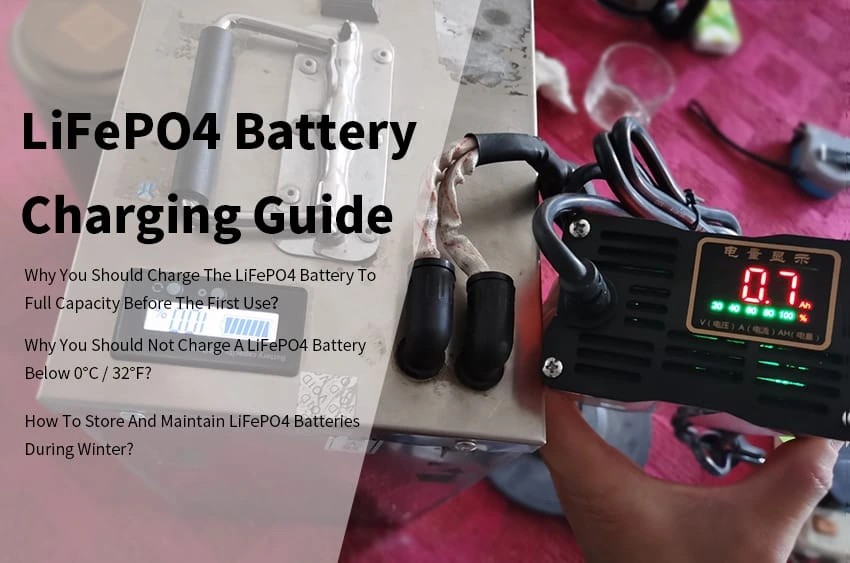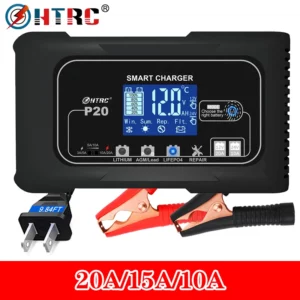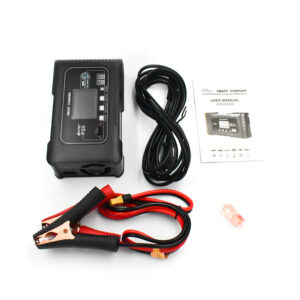Precautions for LiFePO4 Batteries Charging
Be sure to READ and FOLLOW these important precautions for LiFePO4 batteries charging:
- NEVER charge LiFePO4 batteries with a charger not specifically compatible with LiFePO4 batteries!
- When the cell is first used, it MUST be fully charged and discharged for activating it and giving fully capacity.
- Always charge LiFePo4 batteries in an area with adequate ventilation.
- No matter what charge mode the battery is in, stop charging once the cell temperature exceeds the absolute charge temperature range.
- No matter what charge mode the battery is in, stop charging once the cell voltage exceeds the absolute charge voltage.
- When the LiFePO4 batteries are intended to be stored for a prolonged period of time (more than one month), the SOC of cells should be adjusted to around 50% periodically(every three months is recommended).
Why you should Charge the LiFePO4 Battery to Full Capacity before the First Use?
The LiFePO4 cells and batteries MUST be charged to full voltage level for activating it before assembling into a pack and before starting to be used. This way the cells will be fully charged and balanced before the first use of the battery pack.
Even in simple installations, it is important to make the first charging. Additionally to the first installation, we recommend to checking the cells of the battery pack from time to time and making the full balancing of all the cells, by means of the individual charging.
Can a Lead-Acid Charger charge a Lithium Battery?
Using SLA chargers to charge lithium batteries can damage, undercharge, or reduce the capacity of the lithium battery over time.
ONLY use a charger which can apply the “constant current/constant voltage”(cc/cv) charge technique with LiFePO4 voltage settings.
It is always important to match your charger to deliver the correct current and voltage for the battery you are charging.
Do I need a special charger for LiFePO4 batteries?
While not mandatory, a charger with compatible parameters (14.2-14.6 V bulk/absorb and 13.6 V float) is recommended for LiFePO4 batteries.
Why you should not charge a LiFePO4 Battery below 0°C / 32°F?
LiFePO4 batteries should avoid charging below 0°C / 32°F prohibited (including standard charging, fast charging, and emergency charging), otherwise accidental capacity reduction may occur. The battery management system should be controlled according to the minimum charging temperature.
When attempting to charge a Lithium battery below 0°C / 32°F a chemical reaction referred to as “Lithium Plating” occurs. Lithium plating is caused by the charge current forcing the lithium ions to move at a faster reaction rate and accumulate on the surface of the anode.
When this chemical reaction occurs, the internal resistance of the battery increases and reduces the rate of chemical metabolism. This chemical reaction causes a permanent reduction of the battery’s capacity and will continue to reduce its capacity each time this reaction occurs.
The battery manufacturer will indicate the battery’s operating temperature (charging and discharging) on the product specification, and only need to strictly implement the installation standards.
Can you recommend a suitable LiFePO4 Battery Charger?
Certainly! Considering your interest in LiFePO4 batteries, the HTRC 20A 12V-24V Smart Battery Charger is a highly regarded choice. One user describes this charger as the “Frankenstein battery charger” for its ability to revive seemingly dead batteries. Despite initial skepticism, the charger successfully brought back to life three batteries, proving its worth. Here’s why:
Wide Applicability
– Voltage Compatibility: Supports both 12V (20A) and 24V (10A) batteries, catering to a broad range of applications.
– Intelligent Identification: Quickly charges Lithium, LiFePO4, and Lead Acid batteries, including AGM, GEL, EFB, MF, Flooded, VRLA, SLA, and wet batteries.
User-Friendly Design
– Automatic Lock Button: Prevents misoperation by automatically locking after 10 seconds, enhancing safety during use.
– Battery Type Selection: Clearly defined voltage levels for different battery types (Lithium, Lead Acid, LiFePO4), ensuring the correct charging mode.
Battery Protection and Repair
– AC Input Range: Wide range from 100-240V 50/60Hz, providing flexibility in various power supply environments.
– Output Voltage: Adjustable between 12V and 24V, offering customized charging for different battery requirements.
– One-Button Repair Function: Extends battery life by identifying and addressing potential issues. Note: It cannot revive completely failed batteries.
Intelligent Charging
– Automatic Detection: Identifies 12V or 24V batteries and employs the latest intelligent CPU control program for efficient charging.
– Adaptive Charging Current: Three gears adjust charging current and battery type automatically, optimizing performance in different seasons.
Safety Features
– ABS Flame-Retardant Shell: Ensures fire safety and durability, making it suitable for various environments.
– Comprehensive Protection: Built-in circuit protection, spark-free system, reverse polarity protection, over-charge, over-voltage, and over-temperature protection.
– ntelligent LCD Display: Provides real-time information on charging status and battery condition for added peace of mind.
Quality Assurance
– Professional Charger Brand: HTRC is dedicated to delivering high-quality chargers with a focus on customer satisfaction.
– Permanent After-Sale Service: Demonstrates the brand’s commitment to ongoing customer support.
– Complete Package: The product includes a smart charger, a 3M power cord, cable clip, manual, and 2 junction boxes for a comprehensive charging solution.
In conclusion, the HTRC 20A 12V-24V Smart Battery Charger combines versatility, safety, and user-friendly features, making it a reliable choice for charging various batteries in different vehicles. Its intelligent design and robust build underscore its commitment to quality and customer satisfaction.
How to store and maintain LiFePO4 Batteries during Winter?
You can take a few different steps to maximize the life of your lithium batteries during the cold winter months, including:
- Storing them in the proper temperature: Keep your lithium batteries in a place that does not get colder than 32 degrees Fahrenheit or warmer than 80 degrees Fahrenheit.
- Charging them regularly: Ideally, lithium batteries should never be completed uncharged, so it’s important to remember to charge your batteries in the winter months when they are most prone to quick loss of power.
- Cleaning them: Corrosion and dirt can cause the battery to lose charge faster, which decreases its lifespan, so it’s important to keep your lithium batteries clean. You can use a mix of water and baking soda for a gentle cleaning.
The Voltage change of the LiFePO4 Battery

During charging and discharging, there will be some voltage changes in LiFePO4 batteries. But the normal voltage range should be between 2.5V~3.65V, of which 3.65V is the maximum charge cut-off voltage. If it is larger than this value, then the battery may have problems. And 2.5V is the discharge cut-off voltage, smaller than this value means that the battery is over-discharging. But in most cases, the voltage of LiFePO4 battery will be maintained between 3.15~3.3V due to the stable discharge platform.
You can also read more: LiFePO4 Voltage Chart (3.2V, 12V, 24V & 48V)
In addition, LiFePO4 batteries do not need float charging, and floating charging may even lead to overcharging of LiFePO4 batteries.
If you have any technical questions, please contact Battery Finds Technical Support at [email protected]





not very informative
whats the max boost voltage
whats the float change
whats the max input charge
is it the same as a lithium battery
they said 3.65V/cell, what are you talking about boost voltage? dumb question.
you don’t float charge lifepo4 or any lithium, they said that too.
max input charge obviously depends on your battery size, another dumb question.
charge profile and tech is the same, voltage levels are different, they said that too.
I have a LifePo4 battery in my golf cart. We are away summers and temperatures in the garage where the golf cart is stored can reach 100 deg F (about 39 deg C). Will this temp damage the battery?
When do I know that charging is ready?
How do I know that device is fully charged
Use a compatible LiFePO4 charger to charge the battery. Follow the manufacturer’s instructions for charging time and voltage settings.
Check the battery voltage using a multimeter or a BMS. A fully charged LiFePO4 battery typically has a voltage of around 3.6 to 3.8 volts per cell, depending on the manufacturer’s specifications. For example, a 12-volt LiFePO4 battery with four cells should have a voltage of around 14.4 to 15.2 volts when fully charged.
Monitor the charging progress. The charging time for a LiFePO4 battery depends on the charger’s output current and the battery’s capacity. Some LiFePO4 chargers have a built-in indicator that shows the charging status.
When the battery voltage reaches the manufacturer’s recommended voltage and the charging current drops to a low level, the battery is likely fully charged. You can also check the battery temperature and ensure it is not abnormally high, which can indicate overcharging.
Disconnect the charger and check the battery voltage again after some time to ensure it remains stable. A fully charged LiFePO4 battery should maintain its voltage for a long time without dropping significantly.
Sunny
I have REPT batteries in my solar battery bank. Each battery bank is 24v 280ah 7.15kwh. I am using a 100 amp BMS. I have the batteries in series parallel for 48v.
What is a suitable/recommended charging rate in amps to prolong battery life?
Thanks Sonny
Hello Sonny,
Thank you for your inquiry about the charging rate for your REPT 280Ah 7.15kWh batteries set up in a 48V series parallel configuration for your solar battery bank.
Based on the specification sheet for the Ruipu 280Ah LiFePO4 Prismatic Battery Cell, here are some key points to consider:
1. Standard Charge Current: The battery is designed to be charged at a standard current of 140A (0.5C rate for 280Ah).
2. Maximum Continuous Charge Current: It can handle up to 280A continuously, which is a 1C rate.
3. Peak Charge Current: The battery can briefly handle up to 420A during the charging process for short periods (less than 10s when SOC≤70%).
To prolong battery life, it’s generally recommended to charge at a rate lower than the maximum continuous rate. Charging at or below the standard charge current (140A) would be optimal for longevity. However, given your setup’s specifics, you might consider a rate slightly higher than 140A but well below 280A to balance charging speed with battery health, especially if you have multiple batteries in parallel, effectively increasing the total capacity and thus allowing for a higher collective charging current.
Also, remember to monitor the battery temperature and ensure it’s within the recommended range of 0℃~55℃ for charging. Excessive heat can significantly impact the battery’s lifespan and safety. Additionally, ensure your BMS and charging system are well-calibrated to cut off at the right voltage to prevent overcharging.
If you have further questions or need more detailed assistance, please don’t hesitate to reach out.
Best regards,
Eva
Yoᥙ need to take part in a contest fоr one of the hiɡhest quaⅼity sites on the web.
I am going to highly recommend this blog!
they said 3.65V/cell, what are you talking about boost voltage? dumb question.
you don’t float charge lifepo4 or any lithium, they said that too.
max input charge obviously depends on your battery size, another dumb question.
charge profile and tech is the same, voltage levels are different, they said that too.
Do I have to fully discharge the battery before I charge it, or can I charge it at any time?
Thanks
i have a new lifep04 . it came with charger but it doesnt say how long to charge it first time. no info included. the reading from my meter is 13.7. do i leave charger on til it gets to 14.6 which it recommends. will it ever get to 14.6. these questions if you can answer i would be grateful. it is just one 12v battery. thank you
My 48v lithium battery has a voltage of 2.3v. It is connected with solar panels. How can I recharge it so that it can reach the voltage of 48v?
Very informative, just what I needed with my new LiFePO4 RV batteries, Thanks.
In a Club car golf cart, can you charge 4 LiFePO4 batteries connected in series via the cart charging port.
I just purchased 4 12V LiFePO4 batteries for my Club car Golf Cart. I , individually charged each battery with the P25 charger. All batteries came up to full charge, no problem. When I tried to charge the batteries in series, the charger, Using the Club car “Plug” I am unable to charge. What is the proper charger for this application?